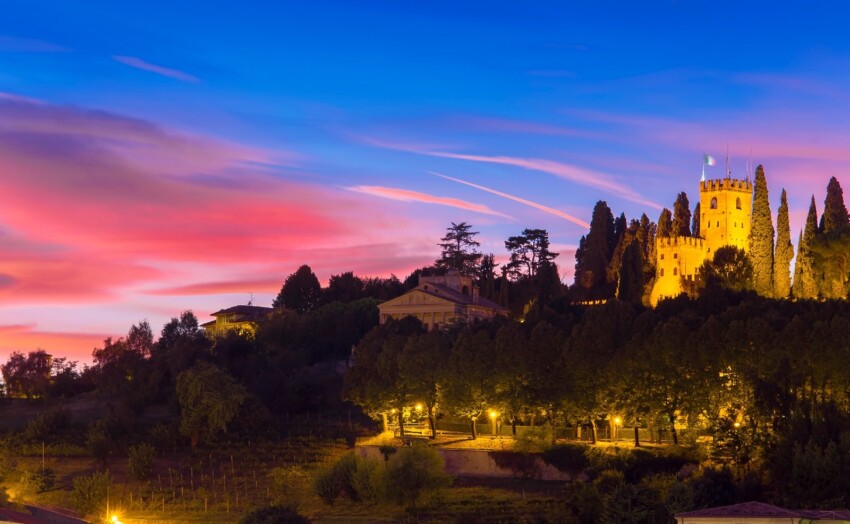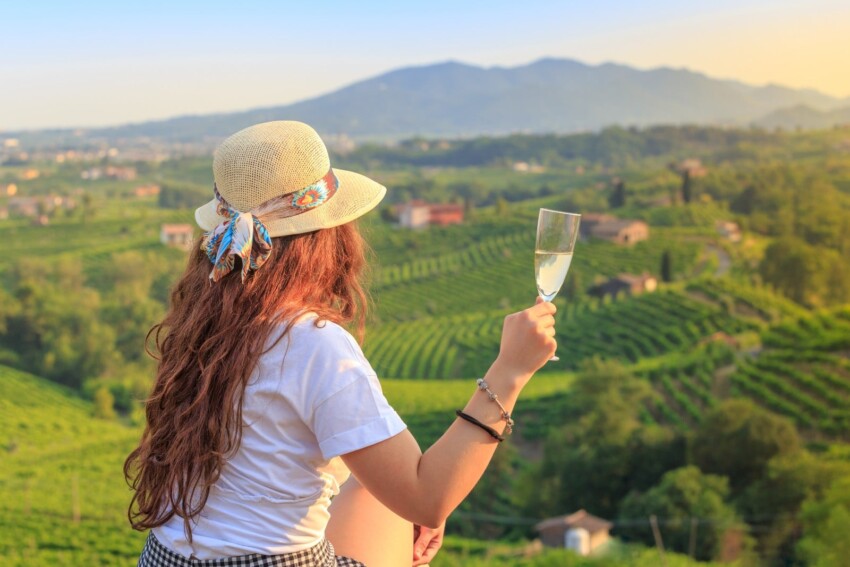

Conegliano is a small town in the Veneto region at the foot of the Trevisan Pre-Alps that boasts a very special top attraction. It is neither a famous museum, nor a precious 14th century altarpiece, nor an avant-garde building of contemporary architecture.
The area’s number one attraction are the Prosecco Hills of Conegliano and Valdobbiadene, gentle hills covered in expanses of vines from which Italy’s most famous bubbles are produced.
Not much? Not according to Unesco, which has included them in its list of World Heritage Sites. We agree, and think that a wine tour of the Prosecco hills with a stop in the cellars for guided tours and tastings is a valid reason for a holiday in Veneto.
Plan your wine and food itinerary so that you have time to take a stroll through the centre of Conegliano Veneto. You may decide to stop here for the night: it is an elegant city, full of beautiful palazzi, historic churches, elegant shops and quality restaurants.
The centre of Conegliano is small and easy to get around on foot. Half a day is enough to visit the main attractions and take a relaxing break in one of the cafés in the centre. You can then easily combine a visit to the city with a tour of the wine cellars in the surrounding area.
The Castle of Conegliano is a splendid medieval construction set in a panoramic position atop the Colle di Giano, a gentle relief in the Treviso Pre-Alps.
Its tower, well preserved and visible from several points on the Treviso plain, is much loved by the inhabitants of Conegliano, who consider it a symbol of the city. The locals call it ‘La Campana’ (‘the bell’) to recall the bell that once summoned the citizens before the start of a municipal council meeting.
The origins of the castle date back to the 13th century; what we see today is the result of extensions and renovations over the centuries.
A visit is highly recommended as the castle is the most beautiful vantage point in Conegliano. From here you can admire the city and the green expanses of vineyards that surround it; on clear days the view extends from the mountains to the sea.
The tower houses a civic museum displaying a collection of paintings, frescoes, tombstones, maps; a section is dedicated to archaeology and local history. There is also a fine restaurant with a panoramic terrace inside the castle.
Contrada Grande is the name given to the main street in the centre of Conegliano. Officially it consists of two streets and a square, namely Via XX Settembre, Piazza Cima and Via Beato Marco Ongaro, but for everyone it is a single street.
Along this route one encounters some elegant buildings of great historical and architectural importance. Among these, the following are certainly worth mentioning: Palazzo Piutti Ex Dalla Balla, the Town Hall, Casa Longega, Palazzo Sarcinelli, Palazzo Montalban Vecchio and Palazzo Montalban Nuovo.
Another interesting palace is the Monte di Pietà, easily recognisable by the frescoed angels decorating its façade.
Cima Square is the centre of the Contrada and consequently the heart of Conegliano’s historical centre. It is a classic Italian piazza lined with elegant palazzi, chosen by Pietro Germi to shoot some key scenes in the film ‘Signore & Signori’, a witty satire of Veneto society in the years of the economic boom.
The northern end of the square is bordered by the Teatro Accademia (Academia Theatre), a neoclassical building dating back to the mid-19th century.
One of the most beautiful buildings along Contrada Granda is the Cathedral of S. Leonardo, the main religious building in the centre of Conegliano.
The original nucleus was built in the 14th century by the Battuti, a religious congregation founded in Umbria in the previous century; the building was later enlarged and modified over the centuries.
The exterior façade of the church is concealed by the Sala dei Battuti (Battuti Room), which with its pointed arches on the ground floor gives continuity to the arcades of the Contrada Grande. The Sala dei Battuti is richly frescoed both inside and out.
Numerous valuable works of art are preserved in the church. Prominent among them is the altarpiece painted by Giambattista Cima at the end of the 16th century.
The former convent of St Francis is a complex of religious buildings erected at the turn of the 14th and 15th centuries by the Franciscans. It is worth entering to take a look at the cloister with courtyard: you can admire the elegant arcades with columns and a 17th-century well.
On the hill behind the convent is the brolo, which for centuries served as a vegetable garden and vineyard for the Franciscans. Recently, the old cultivations have been restored and a beautiful garden has been created.
The Church of Our Lady of the Snows is a small oratory located halfway down the street of the same name near the historical walls and at a tower that serves as a gate.
The origins of the building are uncertain but it is mentioned in written documents from the 16th century onwards. Restoration work carried out in the 1990s restored the church to the appearance it had in the 18th century.
Its official name is the Fountain of Neptune but in Conegliano it is better known as the Fountain of Horses. It is an elegant 19th-century fountain depicting the god holding the trident seated on a shell drawn by two hippocampi.
The fountain we admire today was inaugurated on the occasion of the Austrian Emperor Ferdinand I’s visit to the city, but a public fountain had been present in the city since the 14th century.
Wine production is one of the most important economic activities in and around Conegliano. It is therefore not surprising that there is a museum dedicated to a great researcher and experimenter of oenological techniques.
We are talking about Prof. Luigi Manzoni, the first director of the oldest oenological school in Italy… obviously based in Conegliano! He was responsible for important cross-fertilisations that made it possible to create more resistant vineyards without losing the quality of the wine.
The museum can be visited by appointment.
A particularly suggestive corner of Conegliano, with 19th-century charm, is the Jewish Cemetery on the Cabalan hill. Inside are more than 100 ancient tombstones, many of them oriented towards Jerusalem.
The Jewish Cemetery in Conegliano is a haven of tranquillity suitable for romantic souls and is also an important testimony to the Jewish community in the area.
Enthusiasts of painting can add the Casa Museo Cima to their list of things to see in Conegliano, a building in the town centre that was the residence of the Renaissance painter Giovanni Battista Cima, a native of Conegliano.
The house is located in the street of the same name, once called Ruga Inferiore (Lower Wrinkle), and is home to a museum displaying original paintings by the painter and some archaeological artefacts found during the restoration of the building.
The Dersut Coffee Museum is an interesting museum dedicated to the history of the most typically Italian hot drink: espresso.
The museum is housed in a beautiful industrial archaeology building not far from the headquarters of a famous local coffee producer. These rooms once housed a drying kiln, today they contain four exhibition rooms telling the history of espresso and a tasting room.
The museum is open for groups by appointment. The visit is free of charge.
In the following map you can see the location of the main places of interest mentioned in this article.

The Strada del Prosecco e Vini dei Colli Conegliano Valdobbiadene (Prosecco and Wine Route of the Conegliano Valdobbiadene Hills) is a set of 4 thematic routes designed to enhance the territory of the hills between Conegliano and Valdobbiadene, a very important area for Italian wine production.
The routes make it possible not only to get to know the wine cellars and wine-producing farms, but also to better appreciate the area’s scenic and cultural beauty.
The longest route is a 90 km loop that allows you to visit the two capitals of Prosecco Superiore Docg, Conegliano and Valdobbiadene.
Conegliano Veneto is not a town with a high tourist vocation: the choice of accommodation is good but not particularly wide.
In the historic centre there are a couple of 3- and 4-star hotels with excellent value for money and a few B&Bs. The choice widens if you are willing to move a few kilometres away from the centre. In this case you can find delightful agritourisms, rural houses and villas.
There is no shortage of luxury options, both in the centre and in the surrounding area, for those who want to treat themselves to something special.
Getting to Conegliano Veneto by car is very easy because you can arrive either from the A27 Venice – Belluno motorway or from the A28 Portogruaro – Conegliano motorway. Just take the Conegliano exit and follow the signs: the city centre is just a few kilometres away.
Getting to Conegliano by public transport is also not complicated. The city is located along the Venezia-Belluno, Venezia-Trieste and Venezia-Calalzo railway lines, served by frequent regional trains.
Suburban buses connect Conegliano to the main towns in the province of Treviso, including Vittorio Veneto, Valdobbiadene and Montebelluna.
The nearest airport to Conegliano is Treviso airport, about 40 km away; Venice airport is only 10 km further on.
What's the weather at Conegliano Veneto? Below are the temperatures and the weather forecast at Conegliano Veneto for the next few days.
Conegliano Veneto is a municipality in the province of Treviso located in north-eastern Veneto, not far from the border with Friuli-Venezia Giulia. It is 30 km from the provincial capital, 60 km from Venice and 45 km from Belluno.